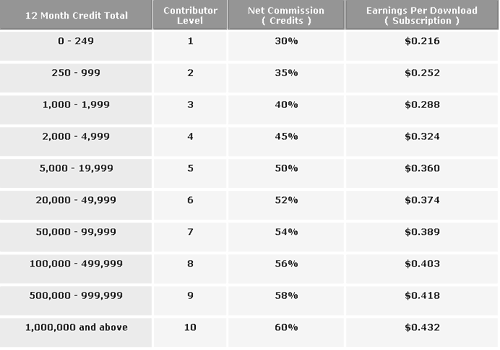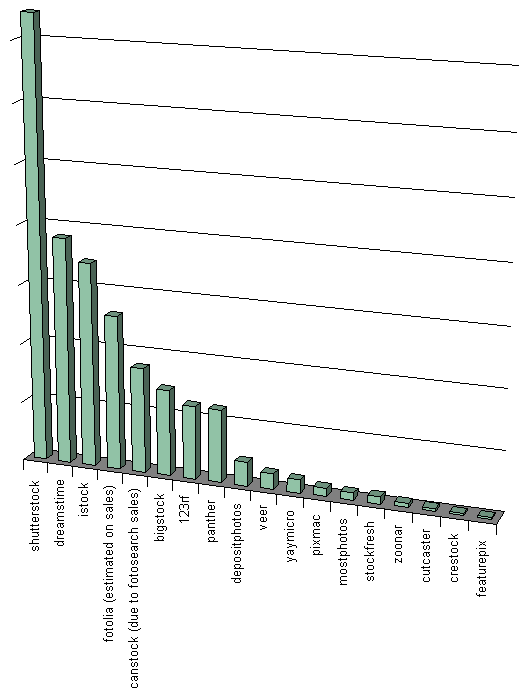I'm trying hard not to make a habit of rolling two months news into one news post, I'll try to keep things monthly! A few big stories since the New Year, probably the most contentious was 123rf changing their royalty rates.
123rf New commission structure
This story starts back in December when some 123rf users received a message (I didn't find out about that till January when I logged in and there was a message on the log in page) about a new commission rates. A thread on microstock group follows the events. Originally the changes were to affect new users only, with existing accounts being grandfathered:
- All existing contributors shall continue to enjoy the current 50% nett commission share ONLY IF they fulfill ALL of the following criteria.:
- Have registered with 123RF.com before February 1, 2012.
- Have at least 150 accepted images in their respective portfolios by January 9, 2012.
- Have had a minimum of 10 paid downloads by January 27, 2012.
- All new contributors who start submitting images to 123RF.com AFTER January 27, 2012 OR do not meet all the criteria above shall be enrolled under the new commission structure.
- For our veteran contributors who have been supporting us all this while, we thank you for your support and we will try our best to grow the business further in 2012. We will also try our very best to maintain the levels of 50% nett commission to you for as long as possible.
However by February that had changed to affect all users:
- 123RF.com will be changing its Contributor Commission Payout on January 1, 2013. From now till then, 123RF.com shall continue paying our Contributors at a rate of:
-
50% net value for credits
-
$0.36 per download for subscriptions

(See the 123rf site for details about how credits are accrued - they are related to resolutions / media types downloaded, e.g. if you sell a lot of high resolution images you will only need to sell 100-200 of them to reach the 3rd tier with 1000 credits in any given previous 12 months.)
My thoughts on all this are:
- 123rf's original 50% rate was way higher than all the other major agencies.
- The new 30% offer (basic) is higher than all the top agencies / compares favorably against dreamstime (see a table of commission rates). The other low tier agencies still offering 50% seem to be "struggling".
- The assertions by some stock photographers that they created the images and they "deserve the lions share of the sale price", I personally think is complete rubbish.
- Despite rises in prices of images/credit 123rf are still cheap compared to other agencies (middle of the table) about 40% cheaper than IS, SS and DT. Although I placed them 7th in earnings last year - see below (7th is not a bad place to be!)... an increase in price or just a few more sales would easily pop them into 5th place for me.
Other News
Bigstock celebrated 10 million images just after new year (doubling their image collection since June 2010).
Cutcaster Announced they had 1 million images in their collection, it's taken some time to get there.
Shutterstock Posted an interesting infographic on design trends and how they have changed over microstock's short history. If you are a shutterstock member you will likely also be aware of changes to their image use policy regarding sensitive uses, you can opt in or out at any time for making your images available for use in circumstances that would not normally be allowed by their standard license terms (images sold under this license are done so at a premium price point).
2011 Earnings Retrospective
According to my earnings over the past 12 months, it seems that 2011 was the "year of shutterstock". The chart below shows my earnings at 18 agencies for comparison - image sales only, referral income is excluded, also see the notes below the graph.

Notes: canstock would be somewhere ahead of deposit photos if it were not for several high value fotosearch sales (but it seems reasonable to include these in the chart)
Fotolia results are estimated based on number of sales, exact value of sales cannot be separated from affiliate revenue at fotolia.
On Other Blogs and Forums
Shutterstock Forum: Where is microstock headed in 2012
Mystock photo on Crestocks 4 million celebrity image collection
Nil to Mil to close - Matt announced he was moving on to new projects
A long discussion on microstock group about istocks best match system - having had 2 months to look, my sales volume is down on last year but their value is higher (it equates overall to a small drop in income that is perhaps not so surprising due to my lack of fresh uploads over the past 12 months, so far its not as miserable as it looked in the first few weeks of the year).
See our twitter and facebook pages for more regular news updates



Microstock =
Sanjay (not verified) on Wed, 2012-02-29 01:14Microstock = Microearnings
Having listed on a dozen or so top stock sites and uploaded like the dickens over almost 3 years, this is what I have to say! Returns on the time, effort and creativity are decreasing to an unacceptable low. With many of the microstock sites aggressively decreasing payout percentages, the returns are on downward spiral. Wondering why we Contributors do more and more work and earn less and less? Well, it wold appear to be the basic rule of supply and demand. On the one hand, looking over some years in time, the microstock agencies are unable to push up buyer rates in a meaningful way. Simply because there are too many microstock agencies with fairly similar content - for the buyer this means oversupply which equates to pressure on prices of the images. Ot at least no significant increase looks possible on buyer rates. And further down the ladder, there are too many Contributors submitting too much content to multiple stock agencies.
Oversupply from Contributors again leads to price pressure - this time from the stock agencies towards the contributors. For the stock agencies therefore it may be a no-brainer to reduce Contributor share of the income. If some leave - who cares - the market is oversupplied. The only Contributors who are likely to be protected are the huge ones, the image factories, with many thousand (and growing) images online - they beat the odds simply on sheer volume not to mention that no stock agency wants to seriously upset them since if they pull out business gets effected. But that's probably a handful of Contributors only and they are the possible exceptions.
For everybody else the future may be bleak if a Contributor is looking for any kind of fair return on the investment in time, effort and creativity. And things may likely get worse going forward since no significant change in the game plan is anywhere in sight. So is it time to get out of the microstock Contributor business altogether?
Thoughts
Steve Gibson on Wed, 2012-02-29 23:58This is going to come out as random thoughts in response:
Oversupply - I don't think we really can have over supply of fresh new interesting images (for buyers) but it will push the producers out towards the 'last man standing'. At 16 million images I still struggle regularly to find certain types of image - ones which are not all that unreasonable to expect to find on a microstock agency (im not asking for the earth). There can be over supply of isolated apples on white background and cloudy skies - we already had that a few years back.
Returns at an unacceptable low - all in perspective compared to initial investment. Compared to some of the people I heard from at microstock expo it would be easy to feel that my reward is at an unacceptable low these days, although it's quite a nice living - it is a lot of work! But I'm also aware that if I work smart enough (not harder) then higher incomes are achievable.... I'm working on it lol, but I'm not blind to the fact that some people are suited to stock and some will never quite get there.
Big producers, yes they are great and they might make 90%+ of the business. But I think the feather in microstocks' hat is the small time individual, uploading 'weird stuff'. If it were just the big producers we will end up the same as traditional RF did, the same 'safe' content churned out over and over without the long tail of rare/unusual/hard to get/specialist stuff that the huge volume of photographers are able to bring ot the table - sadly they just might not make much profit from that. Every image has a value but there are perhaps a lot of images and subjects that are not cost effective as stock microstock, again there will be a constantly moving balance point "contributors vs. sales". Lets not lose sight of the fact that microstock opened up a market for some very simple images that were simply not viable as full price RF.
There is a lot of truth in comments that microstock production will be forced to places where the cost of living is cheaper, but there is also a lot of truth in comments that stock photos produced in those countries 'look like it' and never have mass appeal to buyers overseas. Homeostasis (i.e. your thoughts on price pressures and supply are quite right, but the model is far more complex than "more images = lower price" - image quality/content being so subjective makes one mans valuable stock photo another mans waste of disk space.
Getting out of microstock production - hmm well, grass is always greener isn't it. It takes a certain type of person to move be a stock photographer, and a lot of them (incl myself) suffer (benefit from?) certain personality traits - "ants in the pants" is one of them. There are indeed times to move on and try something new - once you have looked where you are headed, that's just simple business planning.
I'm not sure where you would be heading in the future but nil to mil matt wrote a couple of weeks back about moving his blog on / starting a new one targeted at buyers, while that's all well and good (and I don't know his motivations), if it's were for example because you feel that "there is more money targeting buyers directly" then you had better do your research properly - with microstock agencies, spammy sites with zipfiles, huge corporations and search engines all in the game its absolutely cut-throat trying to target image buyers. Like the quest for the perfect 'profitable niche photos' I think it's wise spend some time on analysis and steering your business looking ahead etc, but not at the day to day running of it.
Cool, thanks for the input!
Sanjay (not verified) on Thu, 2012-03-01 13:34lol
Steve Gibson on Fri, 2012-03-02 00:55ha, I've now painted a wonderful mental image of people at istock with saws chopping off their own legs.
I've used the metaphor recently of some agencies walking towards the cliff and some have already perhaps gone just a little too far, started slipping and there is no return - but I think that is perhaps a little melodramatic!
It think in reality it's more like a budget airline: constant focus on price and a delicate balancing act between costs and providing an 'acceptable' service, managing customer sentiment etc. None of them are intentionally chopping the branch they sit on. It seems they are carefully pushing things as far as they can, because they can... testing the waters as they go.
I do have a feeling (and its' a nebulous, vague... perhaps even glib and un-educated one) that one agency has gone just a little far at the moment, I suspect they are creating a separation from the rest of microstock rather than plotting their own suicide.
Search for experts in the micro stock market
Vlad (not verified) on Thu, 2012-03-29 16:17